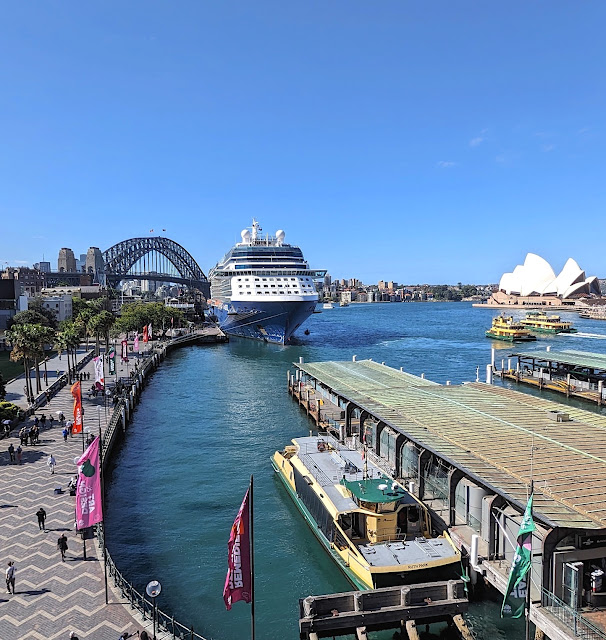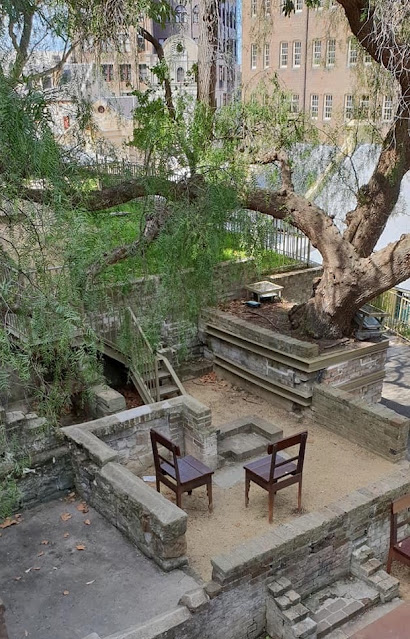The Battery
 |
| Military Battery at Georges Heights, NSW, network of fortifications that were established to protect Sydney Harbour |
The battery was built to defend the entrance to Sydney Harbour during the Napoleonic wars.
The Sydney Gazette reported on 23 October 1803 that:
"The new battery is completed, and the artificers and labourers recalled ... the battery mounts six guns, two long twelves [12 pounders] on the right, two of the same size on the left and two short sixes in the centre. The first of these command the bay inwardly, those on the left command the entrance of the harbour between the heads and those in the centre point across the channel".
See French intuition to invade Australia
here
The fifth Governor of New South Wales, Lachlan Macquarie (1761-1824), arrived in Sydney in 1810 with instructions was to improve the moral fibre of the colony.
Macquarie restored order and discipline after the two years of military rule following the Rum Rebellion of 1808.
Seeing the limits of a convict colony, Macquarie also had many noble
ideals and thoughts that New South Wales should not just be a brutal place of punishment but should allow the chance for redemption and to make good in life,
So he introduced new regulations whereby free settlers and ex-convicts who were "of good conduct and disposition to industry" were entitled to a land grant.
Having a
vision of a free settlers coexisting with the penal settlement, Macquarie began an extensive public works program using convict labour.
In 1819, British Commissioner John Thomas Bigge would investigate accusations that the colony of NSW has become a
land of opportunity for convicts under Governor Lachlan Macquarie.
The Farm
Others were given opportunities as well. Aboriginal man Bungaree of the Garigal clan at Broken Bay, was held in high regard by Matthew Flinders, Governor Lachlan Macquarie and many others.
In fact, Bungaree was recruited to act as an intermediary by Flinders on his circumnavigation of Australia between 1801 and 1803 in Investigator.
In February 1815, Macquarie granted Bungaree and fifteen other Aboriginal men and their families – land at Georges Heights to settle and farm.
The land grant, became known as King Bungaree’s Farm, and Bungaree was given a fishing boat, clothing, seed, implements, pigs and ducks. While he briefly grew peaches and other crops at Georges Heights on this first Aboriginal land grant in the colony, the venture was not a success.
At the ceremony marking the
establishment of the farm, Macquarie presented Bungaree with a metal gorget (breast plate) inscribed “Chief of Broken Bay Tribe”.
 |
| Bungaree was given fine clothing, including military cloaks and a hat. Governor Macquarie took a particular liking to Bungaree, and gave him both the fictitious title ‘King of the Broken Bay Aborigines’ and the first Aboriginal land grant, on Georges Head, where he briefly grew peaches and other produce. Aust Mus |
 |
| Sydney Monitor (NSW : 1828 - 1838), Monday 23 February 1829, |
 |
| Sydney Monitor (NSW : 1828 - 1838), Wednesday 14 July 1830 |
After British forces departed Australia in 1870 and Australia had to organise its own defences,
construction began in 1871 on the battery at Georges Head, which was completed in 1873.
WWII
During World War II, the Sydney Harbour anti-submarine boom net was installed. The boom net spanned the entire width of Sydney Harbour from Green (Laings) Point, Watsons Bay, to Georges Heights in Mosman.
 |
| The Sydney boom defences, looking from George's Head towards Green Point. The anti-submarine net was designed in January 1942, and its construction began that month. It was located at the narrowest point of the inner harbour entrance, between George's Head, on Middle Head, and Green Point on Inner South Head. The single line steel anti-submarine net was supported between piles. When three Japanese midget submarines attacked Sydney Harbour on the night of 31 May 1942, one of the submarines became entangled in the boom net and was destroyed by the crew. AWM |
More Information
Plaque commemorating Bungaree's Farm at Georges Heights, Headland Park, Mosman, Sydney Harbour, NSW here
Georges Head
Around Georges Head Battery
 |
| Military Battery at Georges Heights, NSW, network of fortifications that were established to protect Sydney Harbour |
 |
| Military Battery at Georges Heights, NSW, network of fortifications that were established to protect Sydney Harbour |
 |
| Military Battery at Georges Heights, NSW, network of fortifications that were established to protect Sydney Harbour |
 |
| Military Battery at Georges Heights, NSW, network of fortifications that were established to protect Sydney Harbour |






















































